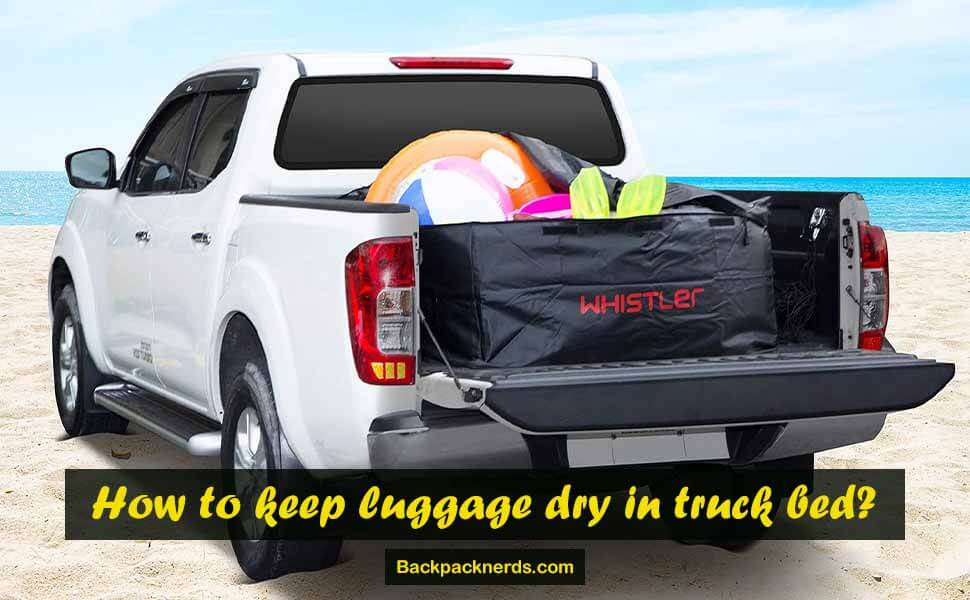Picture this: you’re setting off an exciting road trip, your truck bed packed to the brim with all the essentials for your adventure. However, the looming threat of unpredictable weather can quickly turn your carefully packed luggage into a soggy mess. That’s where the age-old question comes into play: “How to keep luggage dry in a truck bed?” It’s a concern that has plagued many travelers, and in this guide, we’ll find out ingenious ways to ensure that your belongings remain safe and dry throughout your journey. Whether you’re navigating through torrential rain or braving dusty desert winds, we’ve got you covered with smart strategies to keep your luggage dry and your travel plans on track.
How to Keep Luggage Dry in Truck Bed
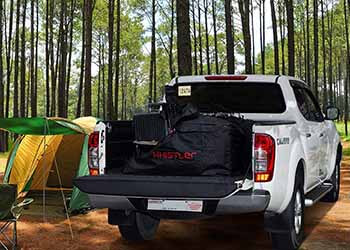
1. Choosing the Right Luggage
The foundation of keeping your luggage dry begins with selecting the right gear. Opting for luggage that is inherently resistant to water is a smart move. Look for bags or suitcases made from waterproof or water-resistant materials. These can be a lifesaver when you encounter sudden downpours or splashes from the road.
Additionally, consider using heavy-duty plastic or rubberized storage bins. These durable containers not only shield your belongings from moisture but also provide extra protection against dust and debris. They come in various sizes, making them adaptable to different types of cargo.
If you’re seeking ultimate protection, vacuum-sealing bags are a game-changer. These airtight wonders not only keep water out but also reduce the volume of your clothing and bedding, making them an excellent choice for space-conscious travelers.
2. Utilizing Truck Bed Covers
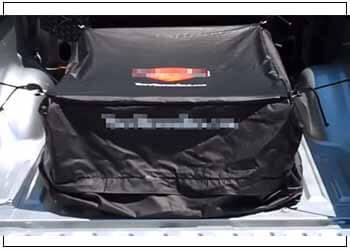
i. Hard-shell truck bed covers:
These robust covers offer maximum protection against the elements. They’re typically made from sturdy materials like aluminum or fiberglass, forming an impenetrable barrier between your luggage and the outside world.
ii. Soft tonneau covers:
These covers are more flexible and lightweight than hard-shell options but still provide reliable weatherproofing. They are easy to install and can be rolled up for quick access to your cargo.
iii. Roll-up covers:
Perfect for those who value convenience, roll-up covers are a versatile choice. They are designed to be user-friendly, allowing you to secure your cargo quickly and easily.
iv. Retractable covers:
Combining the security of hard-shell covers with the flexibility of soft tonneau covers, retractable covers offer a unique solution. They can be pulled back to provide complete access to your truck bed when needed.
These covers serve as the first line of defense against rain, wind, and other elements, ensuring that your luggage remains dry and secure.
3. Waterproofing Your Luggage

Even with the best truck bed covers, a little extra waterproofing can go a long way in safeguarding your belongings. Here are some practical tips:
i. Heavy-duty garbage bags or waterproof liners:
Line the interior of your luggage or storage bins with heavy-duty garbage bags or waterproof liners. This additional layer adds a barrier against moisture and helps keep your items dry.
ii. Sealable storage containers:
Invest in sealable plastic or rubber containers to keep your most valuable or delicate items safe from water damage. These containers come in various sizes and are ideal for electronics, important documents, or anything you want to keep absolutely dry.
iii. Ziplock bags for smaller items:
For small items like toiletries, travel-sized electronics, or snacks, Ziplock bags are your best friends. They’re inexpensive, readily available, and can be a lifesaver in wet conditions.
iv. Silica gel packets:
To combat moisture buildup, toss a few silica gel packets into your luggage or storage containers. These desiccants help absorb excess moisture and prevent the growth of mold or mildew.
By waterproofing your luggage from the inside out, you add an extra layer of protection that ensures your possessions stay dry, even in the most challenging conditions.
In the next section, we’ll explore strategies for strategic packing and how to make the most of your truck bed space while keeping your luggage dry.
4. Strategic Packing
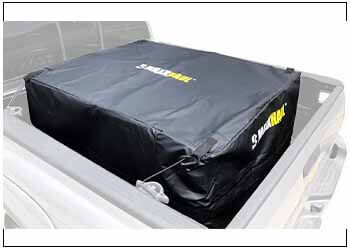
Ensuring the dryness of your luggage in a truck bed isn’t just about external protection; it also involves smart and strategic packing. Here are some key considerations:
i. Elevating luggage off the truck bed floor:
To minimize the risk of water seeping into your luggage from the bottom, consider elevating your bags and containers off the truck bed floor. You can use wooden pallets, plastic crates, or even DIY platforms to create a raised surface. This small adjustment can make a big difference, especially in heavy rains or puddle-prone areas.
ii. Avoiding overloading to prevent compression of items:
Overloading your truck bed with too much luggage can lead to items pressing against each other, potentially causing damage and allowing water to seep in. Distribute the weight evenly, and if needed, use dividers or cushioning materials to create separation between items.
iii. Organizing items based on priority and accessibility:
Think strategically about the order in which you pack your items. Place items you may need during the journey, like snacks, drinks, or an emergency kit, closer to the top for easy access. Less frequently needed items can be packed deeper inside your luggage.
5. Weatherproofing with Tarps
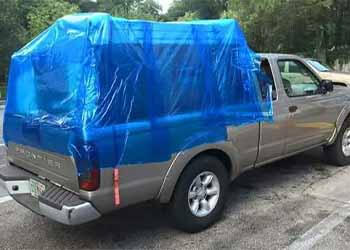
When Mother Nature decides to test your resolve, having a sturdy tarp on hand can save the day. Here’s how to make the most of tarps for weatherproofing:
i. Choosing the right size and type of tarp:
Opt for a tarp that is large enough to cover your entire truck bed and luggage securely. Look for tarps made from heavy-duty materials like polyethylene or vinyl for superior water resistance. Reinforced grommets along the edges will make securing the tarp easier.
ii. Securing the tarp tightly to prevent wind and rain intrusion:
Lay the tarp evenly over your luggage, ensuring that it covers everything snugly. Use bungee cords, tie-down straps, or rope to secure the tarp tightly to the truck bed. Pay extra attention to the corners and edges, as these are vulnerable points for wind and rain to sneak in.
iii. Using bungee cords or tie-down straps for added stability:
Bungee cords or tie-down straps can be invaluable for keeping your tarp in place, especially during high winds or while driving at high speeds. Make sure to fasten them securely to prevent any flapping or shifting of the tarp.
6. Regular Maintenance and Inspections
To keep your luggage dry in a truck bed, it’s essential to practice regular maintenance and inspections:
i. Checking for any tears or wear in covers or tarps:
Inspect your truck bed cover or tarp before each journey. Look for any tears, holes, or signs of wear and tear. Patch up any damage promptly or replace the cover or tarp if necessary.
ii. Re-sealing waterproof containers if necessary:
Over time, the waterproof seals on containers may deteriorate. Check these seals periodically and reseal them with appropriate materials or replace the containers as needed.
iii. Addressing any issues promptly to maintain dryness:
If you encounter unexpected rainfall or a sudden change in weather conditions during your journey, take immediate action to ensure the continued dryness of your luggage. This might include adjusting tarps, tightening straps, or reorganizing items to minimize exposure to moisture.
By following these strategies for strategic packing and weatherproofing, along with regular maintenance and inspections, you can embark on your adventures with confidence, knowing that your luggage will remain dry and ready for whatever the road has in store.
Some Tools and Accessories for keeping Luggage Dry in Truck Bed
How to Cover Truck Bed with Tarp?
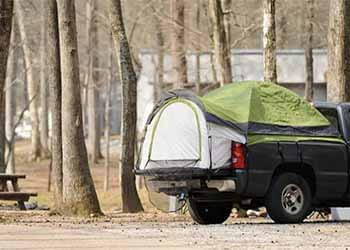
Covering a truck bed with a tarp effectively requires careful preparation and secure fastening to prevent it from coming loose during your journey. Here’s a step-by-step guide on how to cover a truck bed with a tarp:
Materials you’ll need:
- Tarp (choose a size that adequately covers your truck bed)
- Bungee cords, tie-down straps, or rope
- Grommet repair kit (if your tarp has damaged grommets)
- Optional: Tarp clips or clamps for added security
Step-by-Step Guide:
- Select the Right Tarp: Ensure that the tarp you choose is the appropriate size to cover your truck bed fully. It should be made of durable, waterproof or water-resistant material.
- Prepare Your Truck Bed: Remove any loose items, debris, or sharp objects from the truck bed. Ensure that the bed is clean and dry before laying the tarp.
- Lay out the Tarp: Unroll the tarp over your truck bed, ensuring it covers all your luggage and cargo. The excess tarp should hang over the edges.
- Align the Tarp: Make sure the tarp is centered and evenly distributed over your cargo to ensure uniform coverage.
- Secure the Tarp’s Grommets: Many tarps come with grommets (metal or reinforced holes) along the edges. Attach bungee cords, tie-down straps, or rope through these grommets to secure the tarp in place. Start at one corner and work your way around, leaving a small amount of slack to accommodate for stretching.
- Tighten and Secure: Once you’ve threaded your securing materials through the grommets, tighten them to ensure the tarp is snug and won’t flap in the wind. Pay extra attention to the corners and edges, as these areas are prone to lifting.
- Double-Check for Tightness: Walk around your truck bed and inspect the tarp’s tension. Adjust any areas where the tarp may be loose or sagging. A tight tarp minimizes the risk of water or debris getting underneath it.
- Optional: Tarp Clips or Clamps: For added security, you can use tarp clips or clamps to secure the tarp’s edges to your truck bed’s side rails or anchor points. These can help prevent the tarp from shifting or flapping during your journey.
- Trim Excess Tarp: If there’s a significant amount of excess tarp hanging over the edges of your truck bed, trim it carefully to reduce the risk of it catching on wind or obstacles.
- Final Check: Before hitting the road, walk around your truck one last time to ensure that the tarp is securely fastened and that there are no loose areas.
By following these steps and taking the time to properly secure your tarp, you can confidently protect your cargo from rain, wind, and other external factors during your journey. Remember that safety is paramount, so take the necessary precautions to ensure that your tarp remains securely in place throughout your trip.
How to Secure Luggage in Truck Bed?
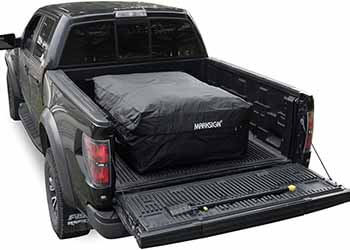
Securing luggage in a truck bed is crucial to ensure it remains safe, undamaged, and in place during your journey. Here’s a step-by-step guide on how to secure luggage in a truck bed effectively:
Materials You’ll Need:
- Ratchet straps or tie-down straps
- Bungee cords or cargo nets
- Durable storage bins or containers (optional)
- Rubber or non-slip mats (optional)
- Tarp or truck bed cover (optional, for weather protection)
Step-by-Step Guide:
- Choose the Right Storage Containers: Before you load your luggage, consider using durable storage bins or containers. These help keep your items organized, protected, and secure. Select containers that fit the shape and size of your luggage.
- Prepare Your Truck Bed: Clear any debris or loose items from the truck bed. If your truck bed has a liner, make sure it’s clean and dry.
- Place Non-Slip Mats (Optional): To prevent your luggage from sliding around during transit, consider placing non-slip rubber mats or liners on the truck bed floor. This provides extra grip and stability.
- Load the Heaviest Items First: Start by loading the heaviest and most stable items at the bottom of the truck bed. This includes items like furniture, large boxes, or heavy equipment. Distribute these items evenly across the bed.
- Secure the Bottom Layer: Use ratchet straps or tie-down straps to secure the bottom layer of items. Pull the straps tight and make sure they are anchored to secure points on your truck bed, such as tie-down hooks or anchor points on the bed rails.
- Layer Lighter Items on Top: Once the heavy items are securely in place, layer lighter and more fragile items on top. This can include luggage, bags, or smaller boxes. Try to distribute the weight evenly.
- Secure the Top Layer: Use additional ratchet straps or tie-down straps to secure the top layer of items. Make sure the straps are tight and anchored to prevent shifting during transit.
- Use Bungee Cords or Cargo Nets: To further secure your luggage and prevent it from shifting or flying out of the truck bed, use bungee cords or cargo nets. Stretch them over the top layer of items, crisscrossing to create a secure web-like structure. Attach them to anchor points on the truck bed.
- Optional: Cover with a Tarp or Truck Bed Cover: If you’re concerned about weather conditions, cover your loaded truck bed with a tarp or install a truck bed cover. Ensure the cover is securely fastened to protect your luggage from rain, wind, or dust.
- Double-Check Your Load: Before hitting the road, walk around your truck and inspect your load. Ensure that all straps, cords, and covers are properly secured and that nothing is loose or shifting.
- Drive Cautiously: When driving with a loaded truck bed, exercise caution, especially during turns, sudden stops, or when encountering uneven terrain. Slow down to reduce the risk of cargo movement.
By following these steps and taking the time to properly secure your luggage, you can enjoy a safe and worry-free journey with your belongings intact and protected. Always prioritize safety and ensure that your cargo is securely fastened before starting your trip. Learn more.
Will Luggage Fly Out Of Truck Bed?
Luggage can potentially fly out of a truck bed if it’s not properly secured. This is especially true if you’re traveling at high speeds, making sudden stops, or encountering strong winds. The risk of luggage flying out of the truck bed is influenced by several factors:
- Speed: Higher speeds generate more wind force, which can exert significant pressure on your luggage. If your luggage isn’t securely fastened, it may become dislodged and be thrown from the truck bed.
- Sudden Stops: Slamming on the brakes can cause unsecured luggage to shift forward, potentially spilling out of the truck bed. Sudden stops can also cause cargo to collide with the rear window of the cab, posing safety risks.
- Wind Gusts: Strong crosswinds or gusty conditions can destabilize unsecured cargo, making it more likely to fly out of the truck bed.
- Sharp Turns: Taking sharp turns or curves at high speeds can cause unsecured items to shift and potentially fall out of the truck bed.
- Lack of Proper Restraints: If you haven’t used proper restraints such as tie-down straps, ratchet straps, bungee cords, cargo nets, or other securing methods, your luggage is more vulnerable to movement and potential ejection.
To prevent luggage from flying out of your truck bed, it’s crucial to take the following precautions:
- Properly Secure Luggage: Use appropriate tie-down straps, bungee cords, cargo nets, or other securing methods to keep your luggage firmly in place.
- Distribute Weight Evenly: Distribute the weight of your cargo evenly to maintain stability and prevent shifting.
- Cover the Cargo: If possible, cover your luggage with a tarp or use a truck bed cover to provide an extra layer of protection against wind and weather.
- Double-Check Your Load: Before driving, always double-check that your cargo is securely fastened and that all restraints are properly tightened.
- Drive Cautiously: Exercise caution when driving with a loaded truck bed. Avoid sudden stops, sharp turns, and excessive speeds, especially when transporting large or heavy items.
Taking these precautions will significantly reduce the risk of luggage flying out of your truck bed, ensuring a safe and secure journey for both you and your cargo. Remember that safety should always be a top priority when transporting items in a truck bed. Read more.
How To Keep Luggage Dry In Truck Bed Without Tonneau Cover?
We already know how to keep luggage dry in truck bed tonneau cover because it has been discussed earlier. But, now, we will try to learn how to keep luggage dry in truck bed without tonneau cover. Well, this is very easy like other methods.
Keeping luggage dry in a truck bed without a tonneau cover can be a bit more challenging, but it’s still possible with some strategic planning and the right materials. Here’s a guide on how to keep your luggage dry in a truck bed without a tonneau cover:
Materials You’ll Need:
- Waterproof tarps (heavy-duty and appropriately sized)
- Ratchet straps or tie-down straps
- Bungee cords or cargo nets
- Durable storage bins or containers
- Plastic or rubber sheets
- Sealable plastic bags
- Silica gel packets (for moisture prevention)
- Non-slip rubber mats (optional)
Step-by-Step Guide:
Knowing to keep your luggage dry in truck bed without tonneau cover is important. In fact, you should know all kinds of methods if you are a frequent adventurer. Let’s now learn how to keep your valuable luggage dry in a truck bed without tonneau cover.
- Prepare Your Truck Bed: Ensure the truck bed is clean, dry, and free of debris or sharp objects that could damage your luggage.
- Choose Waterproof Tarps: Invest in high-quality, heavy-duty waterproof tarps that are large enough to cover your luggage and provide some overlap on the sides.
- Load Luggage Strategically: Place your luggage and items to be transported in durable storage bins or containers. This not only protects them from moisture but also helps with organization.
- Use Plastic or Rubber Sheets: Lay plastic or rubber sheets on the truck bed floor before loading your storage bins. This creates an extra barrier against moisture that might seep through the bed.
- Wrap Fragile Items: For particularly delicate or water-sensitive items, individually wrap them in sealable plastic bags before placing them in the storage bins.
- Place Silica Gel Packets: To prevent moisture buildup, especially in rainy conditions, consider placing silica gel packets inside your storage bins. These help absorb excess moisture and protect your belongings from humidity.
- Secure Luggage with Straps: Use ratchet straps or tie-down straps to secure your storage bins to the truck bed. Pull the straps tight and make sure they are anchored to secure points on your truck bed, such as tie-down hooks or anchor points on the bed rails.
- Cover with Tarps: Carefully drape the waterproof tarps over the secured luggage and storage bins. Ensure that the tarps completely cover your cargo and provide some overhang on all sides.
- Secure Tarps with Straps and Bungee Cords: Use additional ratchet straps, tie-down straps, or bungee cords to secure the tarps tightly over your cargo. Crisscross bungee cords to create a secure web-like structure over the tarps.
- Double-Check for Tightness: Before you hit the road, walk around your truck and inspect the tarps and securing mechanisms. Ensure that everything is properly tightened and that there are no loose areas.
- Drive Cautiously: When driving with a loaded truck bed, exercise caution, especially during turns, sudden stops, or when encountering uneven terrain. Slow down to reduce the risk of cargo movement.
By following these steps and using the right materials, you can effectively protect your luggage from moisture and keep it dry in your truck bed without a tonneau cover. While it may require a bit more effort, proper planning and secure storage can help ensure your belongings remain dry and in good condition during your journey. Learn more from Reddit.
Frequently Asked Questions [How to Keep Luggage Dry in Truck Bed?]
Q1: What’s the best way to protect luggage in a truck bed from rain and water damage?
A1: To safeguard your luggage from rain and water damage, use waterproof tarps to cover your cargo and secure them tightly with straps and bungee cords. Place your belongings in waterproof containers or wrap them in sealable plastic bags for added protection.
Q2: Can I keep luggage dry in a truck bed without using a tonneau cover?
A2: Yes, you can keep luggage dry in a truck bed without a tonneau cover by using waterproof tarps, securing your cargo with straps and bungee cords, and utilizing waterproof storage containers or bags. Proper planning and securing methods are key.
Q3: How can I prevent moisture buildup inside my luggage during long journeys?
A3: To prevent moisture buildup inside your luggage, consider placing silica gel packets inside your storage bins. These packets help absorb excess moisture and maintain a dry environment for your belongings, especially in humid or rainy conditions.
Q4: Are there any additional steps to take to protect fragile items from moisture and damage in a truck bed?
A4: Yes, for fragile items, it’s advisable to individually wrap them in sealable plastic bags before placing them in storage bins. This extra layer of protection helps shield them from moisture and potential impacts during transit.
Q5: How can I ensure that my luggage remains secure in the truck bed while driving?
A5: To ensure your luggage remains secure while driving, use ratchet straps or tie-down straps to firmly secure storage bins to the truck bed. Additionally, use bungee cords or cargo nets to create a web-like structure over your cargo and prevent any shifting or flying out of the truck bed. Always drive cautiously and avoid abrupt maneuvers to reduce the risk of cargo movement.
Final Words
In conclusion, keeping your luggage dry in a truck bed requires a combination of thoughtful choices in luggage, proper covers, waterproofing measures, strategic packing, and vigilance during your travels. With these strategies in place, you can focus on the joy of the journey ahead, rain or shine.
Read More Articles:
- What Does 50 Pounds of Luggage Look Like?
- Will Chocolate Melt In Checked Luggage?
- SKYMOVE 19 Inch Wheeled Rolling Backpack
- Best Backpack for Seniors
- Accidentally Left Battery in Checked Luggage
- How to Wear a Backpack Purse?
- Can Teachers Look Through Your Backpack?
- Best Lightweight Luggage for Seniors
- Travelpro Maxlite 5 Backpack
- How to Set Coolife Luggage Lock?
- Best Backpack with Charger
- How Do Charging Backpacks Work?

